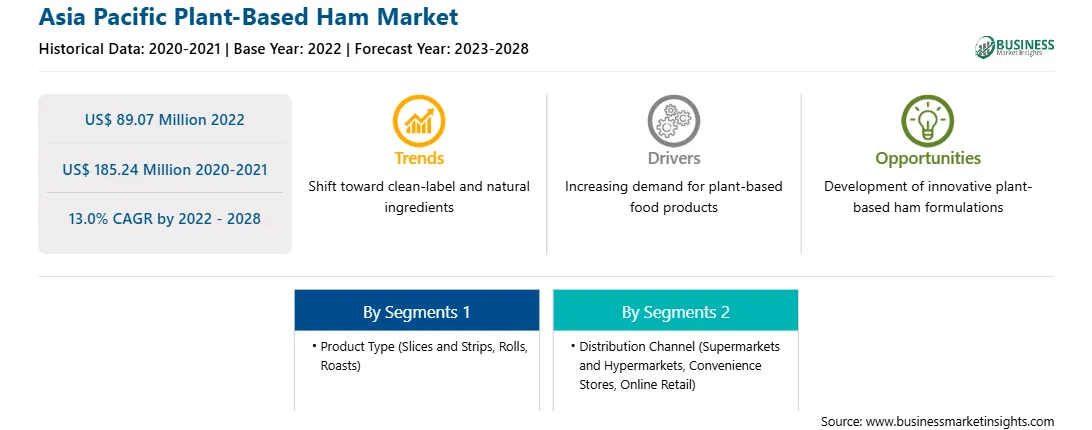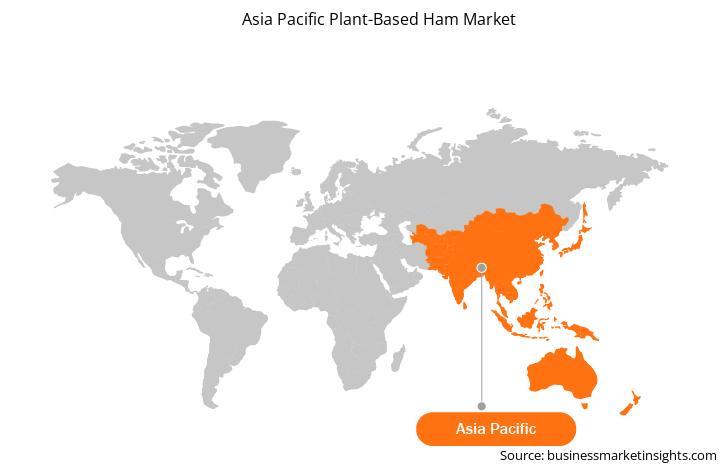Asia Pacific Plant-Based Ham Market
No. of Pages: 93 | Report Code: BMIRE00028091 | Category: Food and Beverages
No. of Pages: 93 | Report Code: BMIRE00028091 | Category: Food and Beverages
Product Innovation will be Driving the Asia Pacific Plant-Based Ham Market
Plant-based ham manufacturers are making significant investments in product innovation to offer organic, gluten-free, non-GMO, and allergen-free products for attracting a large number of consumers. Moreover, they are using plant proteins other than soy and pea protein to differentiate their products from their competitors. Plant-based ham manufacturers are also developing products that address the local needs of consumers. For instance, pork is one of the most consumed meats in Asia; however, a limited number of plant-based pork manufacturers operate in this region. As a result, startups such as OmniPork entered Asia in 2018, and in its first two years of operation, the product has witnessed tremendous growth in not only its native Hong Kong but also in Singapore, Macau, Mainland China, Thailand, Taiwan, where around one million OmniPork products have been sold every single week since their launch in January. These developments are expected to surge the demand for plant-based ham.
Asia Pacific Plant-Based Ham Market Overview
The Asia Pacific plant-based ham market is further segmented into Australia, China, Japan, South Korea, and the rest of Asia Pacific. In addition to health consciousness among consumers, religious beliefs contribute to the demand for plant-based meat products in this region. The excessive intake of animal-based food has been linked to diet-related disorders, including obesity, Type 2 diabetes, heart disease, and cancer. According to the “International Diabetes Federation (IDF),” India had 77 million diabetic patients in 2019, which is the world's second-largest diabetic population nationwide; this population is further expected to reach 101 million by 2030. Per the IDF data, ~114 million adults in China had diabetes in 2019. With the high prevalence of diabetes and other similar diseases, consumers are increasingly becoming aware of the importance of a healthy diet and an active lifestyle, resulting in greater public attention toward plant-based products, including ham. In December 2020, Nestlé SA launched a new range of plant-based deli meat under the Harvest Gourmet brand in China. The product line includes meatless alternatives to ham, salami, and sausages. The increasing cases of diseases caused by microbial contamination in food—such as trichinosis from pork, salmonella from poultry, scrapie from lamb, and vibrio illness and norovirus infections from fish—are driving consumer inclination toward plant-based alternatives. Additionally, the busy lifestyle of the urban middle-class population and the lack of nutrients in an individual’s diet are the other factors supporting the Asia Pacific plant-based ham market growth.
Strategic insights for the Asia Pacific Plant-Based Ham provides data-driven analysis of the industry landscape, including current trends, key players, and regional nuances. These insights offer actionable recommendations, enabling readers to differentiate themselves from competitors by identifying untapped segments or developing unique value propositions. Leveraging data analytics, these insights help industry players anticipate the market shifts, whether investors, manufacturers, or other stakeholders. A future-oriented perspective is essential, helping stakeholders anticipate market shifts and position themselves for long-term success in this dynamic region. Ultimately, effective strategic insights empower readers to make informed decisions that drive profitability and achieve their business objectives within the market. The geographic scope of the Asia Pacific Plant-Based Ham refers to the specific areas in which a business operates and competes. Understanding local distinctions, such as diverse consumer preferences (e.g., demand for specific plug types or battery backup durations), varying economic conditions, and regulatory environments, is crucial for tailoring strategies to specific markets. Businesses can expand their reach by identifying underserved areas or adapting their offerings to meet local demands. A clear market focus allows for more effective resource allocation, targeted marketing campaigns, and better positioning against local competitors, ultimately driving growth in those targeted areas.
Asia Pacific Plant-Based Ham Strategic Insights

Asia Pacific Plant-Based Ham Report Scope
Report Attribute
Details
Market size in 2022
US$ 89.07 Million
Market Size by 2028
US$ 185.24 Million
Global CAGR (2022 - 2028)
13.0%
Historical Data
2020-2021
Forecast period
2023-2028
Segments Covered
By Product Type
By Distribution Channel
Regions and Countries Covered
Asia-Pacific
Market leaders and key company profiles
Asia Pacific Plant-Based Ham Regional Insights

Asia Pacific Plant-Based Ham Market Segmentation
The Asia Pacific plant-based ham market is segmented into product type, distribution channel, and country.
Based on product type, the Asia Pacific plant-based ham market is segmented into slices and strips, rolls, and roasts. In 2022, the slices and strips segment registered a largest share in the Asia Pacific plant-based ham market.
Based on distribution channel, the Asia Pacific plant-based ham market is segmented into supermarkets and hypermarkets, convenience stores, online retail, and others. In 2022, the supermarkets and hypermarkets segment registered a largest share in the Asia Pacific plant-based ham market.
Based on country, the Asia Pacific plant-based ham market is segmented into Australia, China, Japan, South Korea, and the Rest of Asia Pacific. In 2022, China segment registered a largest share in the Asia Pacific plant-based ham market.
Hain Celestial Canada ULC; Mantra Food Thailand Co Ltd; Meliora Foods Pty Ltd; Nestle SA; Quorn Foods Ltd; and VBites Foods Ltd are the leading companies operating in the Asia Pacific plant-based ham market.
The Asia Pacific Plant-Based Ham Market is valued at US$ 89.07 Million in 2022, it is projected to reach US$ 185.24 Million by 2028.
As per our report Asia Pacific Plant-Based Ham Market, the market size is valued at US$ 89.07 Million in 2022, projecting it to reach US$ 185.24 Million by 2028. This translates to a CAGR of approximately 13.0% during the forecast period.
The Asia Pacific Plant-Based Ham Market report typically cover these key segments-
The historic period, base year, and forecast period can vary slightly depending on the specific market research report. However, for the Asia Pacific Plant-Based Ham Market report:
The Asia Pacific Plant-Based Ham Market is populated by several key players, each contributing to its growth and innovation. Some of the major players include:
The Asia Pacific Plant-Based Ham Market report is valuable for diverse stakeholders, including:
Essentially, anyone involved in or considering involvement in the Asia Pacific Plant-Based Ham Market value chain can benefit from the information contained in a comprehensive market report.